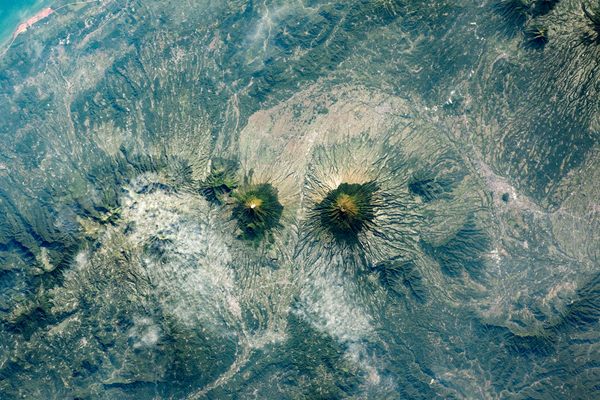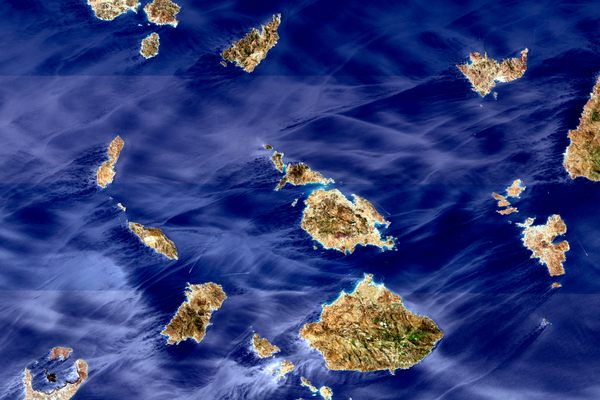This Remote, Active Volcano Is a Glassblowing Spider
Alaska’s Great Sitkin has been grumbling for nearly a year.
Near the tip of Alaska’s long tail of islands, a dotted line that curves across the North Pacific toward Asia, there is a giant spider lying in wait. The creature, made of fire and molten rock, sits at the center of a web spun of ice and frozen lava, its heart blood-red from its own heat.
This is not a scene from a fantasy novel. It’s an image captured by a satellite passing above Alaska’s brooding Great Sitkin volcano, which rises more than 5,700 feet above the surf. The volcano takes up about half of the island of the same name, which is part of the Alaska Maritime National Wildlife Refuge. While Great Sitkin has not had a large eruption since the mid-1970s, it has been letting off steam, literally, on and off since 2016. On May 25, 2021, a minor eruption lasted for a couple minutes—the initial explosion was heard as a loud bang 30 miles away. Since then, the volcano has continued to grumble. Increased seismic activity and the occasional burp of ash, steam, or lava have earned it the distinction of having a daily status of orange or red, the two highest alert levels, for nearly a year.
The image above, acquired earlier this month, shows two rivers of lava snaking from the volcano’s mouth down its snowy southwest side. If this meeting of fire and frozen water looks a little strange, it’s because lava and ice do some interesting things when they get together. While the consequences can be catastrophic—for example, under the right circumstances, the eruption of an ice-covered volcano can trigger a devastating jökulhlaup, a megaflood most closely associated with Iceland’s subglacial volcanoes—the more typical interaction is, well, glassblowing.

In a 2013 Geology paper, researchers described what happened when lava met ice in several different scenarios, with a wide range of results. In experiments at the Syracuse University Lava Project, the molten goo sometimes found cracks or other imperfections in ice blocks used for the test, and would work its way downward as well as forward wherever it could.
In other runs of the experiment, when the lava hit a solid, crack-free ice surface, it at first traveled quickly, melting as it went, but soon proved to be its own worst enemy. The lava simply sank into the depression it had created, its advance halted by the cliff-like barrier of ice that had withstood the initial melt. Outside of the lab, this kind of lava vs. ice showdown, where the ice essentially wins, results in an ice-marginal lava flow. After the ice finally melts, long after the lava has cooled, what’s left behind is a thick, blunt wall of rock called a lava dam.
The scientists found, however, that regardless of surface condition or other factors, the interaction of lava and ice always produced lava bubbles. As the lava made contact, the ice turned straight into steam that bubbled upward through the lava. When they arrived at the flow’s surface and hit the chilly air, the bubbles cooled quickly, forming numerous, thin-walled spheres of obsidian, a natural glass. “All flows cooled to an essentially crystal-free glass,” the team reported.

The process is something like glassblowing, where air is methodically introduced into molten material to create the desired form, which is then rapidly cooled to preserve its shape. Alas, the spherical obsidian formed when lava meets ice are not so well preserved. Sitting atop moving rivers of lava, lashed by wind and precipitation, they’re prone to shattering. En masse, they end up resembling dull gray and black fields of snow-dusted debris, even as red-hot lava continues to flow beneath them.
That’s why, in the satellite image above, the active rivers of lava appear relatively uninteresting, just two tracks of dirty snow that lead away from the volcano’s spider-like center. The only hint of Great Sitkin’s ongoing turbulence is the molten glow at that central vent, and at the very tips of the lava’s advance, where it is not yet covered by shattered glass of its own making.



























Follow us on Twitter to get the latest on the world's hidden wonders.
Like us on Facebook to get the latest on the world's hidden wonders.
Follow us on Twitter Like us on Facebook